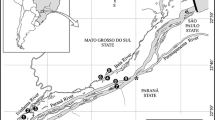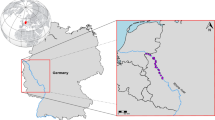Abstract
To what extent do patterns of invasion in one region generalize to other regions? Answering this question is a key goal of invasion biology because it underlies whether we can make progress via comparative studies or must instead cope with a large set of unique cases. Here we quantify similarities and differences in the historical development of nonnative fish assemblages of two North American desert drainages, one with many nonnative fishes (Gila Basin, principally southwestern USA), and one with few (Yaqui Basin, principally northwestern Mexico). The two river basins are similar in size, physiography, and ecology, but because of differences in the timing of regional development, we hypothesized that richness and geographic spread of nonnative fishes in the Yaqui are time-lagged relative to the Gila, and that a slow, but steady increase of nonnative fish occurrence is underway in the Yaqui, similar to what has already occurred in the Gila. Using the comprehensive SONFISHES database, we found that increases in the regional richness of extant nonnative species over time have been roughly linear in both basins. Meanwhile, previously established species have continued to spread spatially, such that the cumulative number of reach records for nonnative species has increased roughly exponentially in both systems. The current status of nonnatives in the Yaqui is remarkably similar to what was evident from the Gila in the past at a comparable level of sampling effort. For all measures of invasion dynamics we examined, a time lag of ∼ 40–50 years exists between the Gila and Yaqui. The majority of extant nonnative fishes are known piscivores, and many have high levels of parental care, a life history trait that affords considerable advantages over native fishes. These results predict that, absent strong action now, the presently abundant native fish fauna of the Yaqui may become increasingly imperiled over the next several years, with a future similar to the Gila, where most native fishes are either extirpated, threatened, or substantially reduced in range, at least partially due to nonnative fishes. We recommend immediate actions to identify and protect high priority portions of the Yaqui Basin from further nonnative fish invasion before further degradation occurs.
Similar content being viewed by others
References
Abarca FJ, Young KL, Jensen BL, Parra I, Bettaso R and Cobble K (1995) Yaqui River fishes relevant to the Madrean Province: US–Mexico collaborations. In: DeBano LF, Folliott PF, Ortega-Rubio A, Gottfried GJ, Hamre RH and Edminster CB (eds) Biodiversity and Management of the Madrean Archipelago: the Sky Islands of Southwestern United Sates and Northwestern Mexico. 19–23 September 1994; Tucson, Arizona, pp 370–378. General Technical Report RM-GTR-264. Fort Collins, Colorado US Department of Agriculture, Forest Service, Rocky Mountain Forest and Range Experiment Station
Barber WE and Minckley WL (1966) Fishes of Aravaipa Creek, Graham and Pinal counties, Arizona. The Southwestern Naturalist 11: 113–124
Brown LR and Moyle PB (1991) Changes in habitat and microhabitat partitioning with an assemblage of stream fishes in response to predation by Sacramento squawfish (Ptychocheilus grandis). Canadian Journal of Fisheries and Aquatic Sciences 48: 849–856
Campoy-Favela J, Varela-Romero A and Juárez-Romero L (1989) Observaciones sobre la ictiofauna nativa de la Cuenca del Río Yaqui, Sonora, Mexico. Ecologica 1: 1–13
Cassey P (2002) Life history and ecology influences establishment success of introduced land birds. Biological Journal of the Linnean Society 76: 465–480
Clark JS, Fastie C, Hurtt G, Jackson ST, Johnson C, King GA, Lewis M, Lynch J, Pacala S, Prentice C, Schupp EW, Webb T and Wyckoff P (1998) Reid's paradox of rapid plant migration – Dispersal theory and interpretation of paleoecological records. Bioscience 48: 13–24
Douglas ME, Marsh PC and Minckley WL (1994) Indigenous fishes of western North America and the hypothesis of competitive displacement: Meda fulgida (Cyprinidae) as a case study. Copeia 1994: 9–19
Dudley RK and Matter WJ (2000) Effects of small green sun-fish (Lepomis cyanellus) on recruitment of Gila chub (Gila intermedia) in Sabino Creek, Arizona. The Southwestern Naturalist 45: 24–29
Echelle AA and Echelle AF (1994) Assessment of genetic introgression between two pupfish species, Cyprinodon elegans and C. variegatus (Cyprinodontidae), after more than 20 years of secondary contact. Copeia 1994: 590–597
Fagan WF, Unmack PJ, Burgess C and Minckley WL (2002) Rarity, fragmentation, and extinction risk in desert fishes. Ecology 83: 3250–3256
Fuller PL, Nico LG and Williams JD (1999) Nonindigenous Fishes Introduced into Inland Waters of the United States. American Fisheries Society Special Publication 27, American Fisheries Society, Bethesda, Maryland, 613 pp
Griffith JS and Tiersch TR (1989) Ecology of fishes in Redfield Canyon, Arizona, with emphasis on Gila robusta intermedia. The Southwestern Naturalist 34: 131–134
Grotkopp E, Rejmanek M and Rost TL (2002) Toward a causal explanation of plant invasiveness: seedling growth and life-history strategies of 29 pine (Pinus) species. American Naturalist 159: 396–419
Hendrickson DA and Juárez-Romero L (1990) Los peces de la cuenca delRío de la Concepción, Sonora,México, y el status del charalito sonorense, Gila ditaenia, una especie en amenaza de extinción. The Southwestern Naturalist 35: 177–187
Hendrickson DA and Varela-Romero A (1989) Conservation status of the endangered desert pupfish, Cyprinodon macularius, in Mexico and Arizona. Copeia 1989: 478–483
Hendrickson DA, Minckley WL, Miller RR, Siebert DJ and Minckley PH (1981) Fishes of the Río Yaqui basin, Mexico and United States. Journal of the Arizona–Nevada Academy of Sciences 15: 65–106
Hendrickson DA, Espinosa-Pérez H, Findley LT, Forbes W, Tomelleri JR, Mayden RL, Nielsen JL, Jensen B, Ruiz-Campos G, Varela-Romero A, van der Heiden A, Camarena F and García de León FJ (2002) Mexican native trouts: a review of their history and current systematic and conservation status. Reviews in Fish Biology and Fisheries 12: 273–316
Holway DA, Suarez AV and Case TJ (2002) Role of abiotic factors in governing susceptibility to invasion: a test with argentine ants. Ecology 83: 1610–1619
Hubbs CL and Miller RR (1943) Mass hybridization between two genera of cyprinid fishes in the Mohave Desert California. Papers of the Michigan Academy of Science Arts and Letters 28: 343–378
Lewis MA and Kareiva P (1993) Allee dynamics and the spread of invading organisms. Theoretical Population Biology 43: 141–158
Marchetti MP (1999) An experimental study of competition between the native Sacramento perch (Archoplites interruptus) and introduced bluegill (Lepomis macrochirus). Biological Invasions 1: 55–65
Marsh PC and Brooks JE (1989) Predation by Ictaluridae catfishes as a deterrent to re-establishment of introduced razorback suckers. The Southwestern Naturalist 34: 188–195
Marsh PC and Douglas ME (1997) Predation by introduced fishes on endangered humpback chub and other native species in the Little Colorado River, Arizona. Transactions of the American Fisheries Society 126: 343–346
Marsh PC and Langhorst DR (1988) Feeding and fate of wild larval razorback suckers. Environmental Biology of Fishes 21: 59–67
Marsh PC and Pacey CA Immiscibility of native and nonnative fishes. In: Proceedings, Restoring Native Fish to the Lower Colorado River: interactions of Native and Non-Native Fishes. US Fish and Wildlife Service, Albuquerque, New Mexico and US Bureau of Reclamation, Boulder City, Nevada (in press)
Marsh PC, Brooks JE, Hendrickson DA and Minckley WL (1991) Fishes of Eagle Creek, Arizona, with records for threatened spikedace and loach minnow (Cyprinidae). Journal of the Arizona–Nevada Academy of Sciences 23: 107–116
Meffe GK (1985) Predation and species replacement in American southwestern fishes: a case study. The Southwestern Naturalist 30: 173–187
Miller RR (1958) Origin and affinities of the freshwater fish fauna of western North America. In: Hubbs CL (ed) Zoogeography. 51, pp. 187–222. American Society for the Advancement of Science Publication, Washington, DC
Miller RR (1961) Man and the changing fish fauna of the American Southwest. Papers of the Michigan Academy of Science Arts and Letters 46: 365–404
Miller RR and Alcorn JR (1946) The introduced fishes of Nevada, with a history of their introduction. Transactions of the American Fisheries Society 73: 173–193
Minckley WL (1973) Fishes of Arizona. Arizona Game Fish Department, Phoenix, Arizona, 293 pp
Minckley WL (1991) Native fishes of the Grand Canyon region: an obituary? In: Colorado River Ecology and Dam Management, pp 124–177. National Academy of Science Press, Washington, DC
Minckley WL (1999). Fredric Morton Chamberlain's survey of Arizona fishes in 1904, with annotations. Journal of the Southwest 41: 177–237
Minckley WL and Deacon JE (1968) Southwestern fishes and the enigma of ‘endangered species’. Science 159: 1424–1432
Minckley WL and Meffe GK (1987) Differential selection for native fishes by flooding in streams of the arid American Southwest. In: Matthews WJ and Heins DC(eds) Ecology and Evolution of North American Stream Fish Communities, pp 93–104 and references therein. University of Oklahoma Press, Norman, Oklahoma
Minckley WL, Hendrickson DA and Bond CE (1986) Geography of western North American freshwater fishes: description and relationships to intracontinental tectonism. In: Hocutt CD and Wiley EO (eds) Zoogeography of North American Freshwater Fishes, pp 516–613 and references therein. JohnWiley and Sons, New York
Minckley WL, Marsh PC, Deacon JE, Dowling TE, Hedrick PW, Matthews WJ and Mueller G (2003) A conservation plan for native fishes of the Lower Colorado River. Bioscience 53: 219–234
Moyle PB (2002) Inland Fishes of California, Revised and Expanded. University of California Press, Berkeley, California, 502 pp
Moyle PB and Light T (1996) Fish invasions in California: do abiotic factors determine success? Ecology 77: 1666–1670
Mueller GA and Marsh PC (2002) Lost, a desert river and its native fishes: a historical perspective of the Lower Colorado River. United States Geological Survey Information and Technology Report USGS/BRD/ITR-2002-0010. Government Printing Office, Denver, Colorado, 69 pp
Propst DL and Stefferud JA (1994) Distribution and status of the Chihuahua chub (Teleostei: Cyprinidae: Gila nigrescens), with notes on its ecology and associated species. The Southwestern Naturalist 39: 224–234
Rahel FJ (2000) Homogenization of fish fauna across the United States. Science 288: 854–856
Rinne JN (1988) Native southwestern (USA) trouts: status, taxonomy, ecology, and conservation. Polish Archives of Hydrobiology 35: 305–320
Rinne JN and Minckley WL (1985) Patterns of variation and distribution in Apache trout (Salmo apache) relative to co-occurrence with introduced salmonids. Copeia 1985: 285–292
Rinne JN and Minckley WL (1991) Native Fishes of Arid Lands: a Dwindling Resource of the Desert Southwest. US Forest Service General-Technical Report. RM-206. Fort Collins, Colorado
Rinne JN and Janisch J (1995) Coldwater fish stocking and native fishes in Arizona: past, present, and future. American Fisheries Society Symposium 15: 397–406
Rinne JN and Turner PR (1991) Reclamation and alteration as management techniques, and a review of methodology in stream renovation. In: Minckley WL and Deacon JE (eds) Battle Against Extinction: Native Fish Management in the American West, pp 219–244 and references therein. University of Arizona Press, Tucson, Arizona
Shigesada N and Kawasaki K (1997) Biological Invasions: Theory and Practice. Oxford University Press, Oxford, UK, 205 pp
Taylor JN, Courtenay WR Jr and McCann JA (1984) Known impacts of exotic fishes in the continental United States. In: Courtenay WR Jr and Stauffer JR Jr (eds) Distribution, Biology, and Management of Exotic Fishes, pp 322–373. John Hopkins University Press, Baltimore, Maryland
Unmack PJ (2002) Arizona State University GIS Manual For Use With the Lower Colorado Basin Fish Database. Biology Department, Arizona State University, Tempe, Arizona. www.peter.unmack.net/gis/fish/colorado/manual.pdf
U.S. Fish andWildlife Service (USFWS) (1994) Yaqui fishes recovery plan. U.S. Fish and Wildlife Service, Albuquerque, New Mexico
U.S. Fish and Wildlife Service (USFWS) (1999) Endangered and Threatened Wildlife and Plants, 50 CFR 17.11 and 17.12. U.S. Fish and Wildlife Service, Washington, DC
Williams JD, Bowman DB, Brooks JE, Echelle AA, Edwards RJ, Hendrickson DA and Landye JJ (1985) Endangered aquatic ecosystems in North American deserts with a list of vanishing fishes of the region. Journal of the Arizona–Nevada Academy of Sciences 20: 1–62
Author information
Authors and Affiliations
Corresponding author
Rights and permissions
About this article
Cite this article
Unmack, P.J., Fagan, W.F. Convergence of Differentially Invaded Systems toward Invader-dominance: Time-lagged Invasions as a Predictor in Desert Fish Communities. Biological Invasions 6, 233–243 (2004). https://doi.org/10.1023/B:BINV.0000022142.77046.4f
Issue Date:
DOI: https://doi.org/10.1023/B:BINV.0000022142.77046.4f




